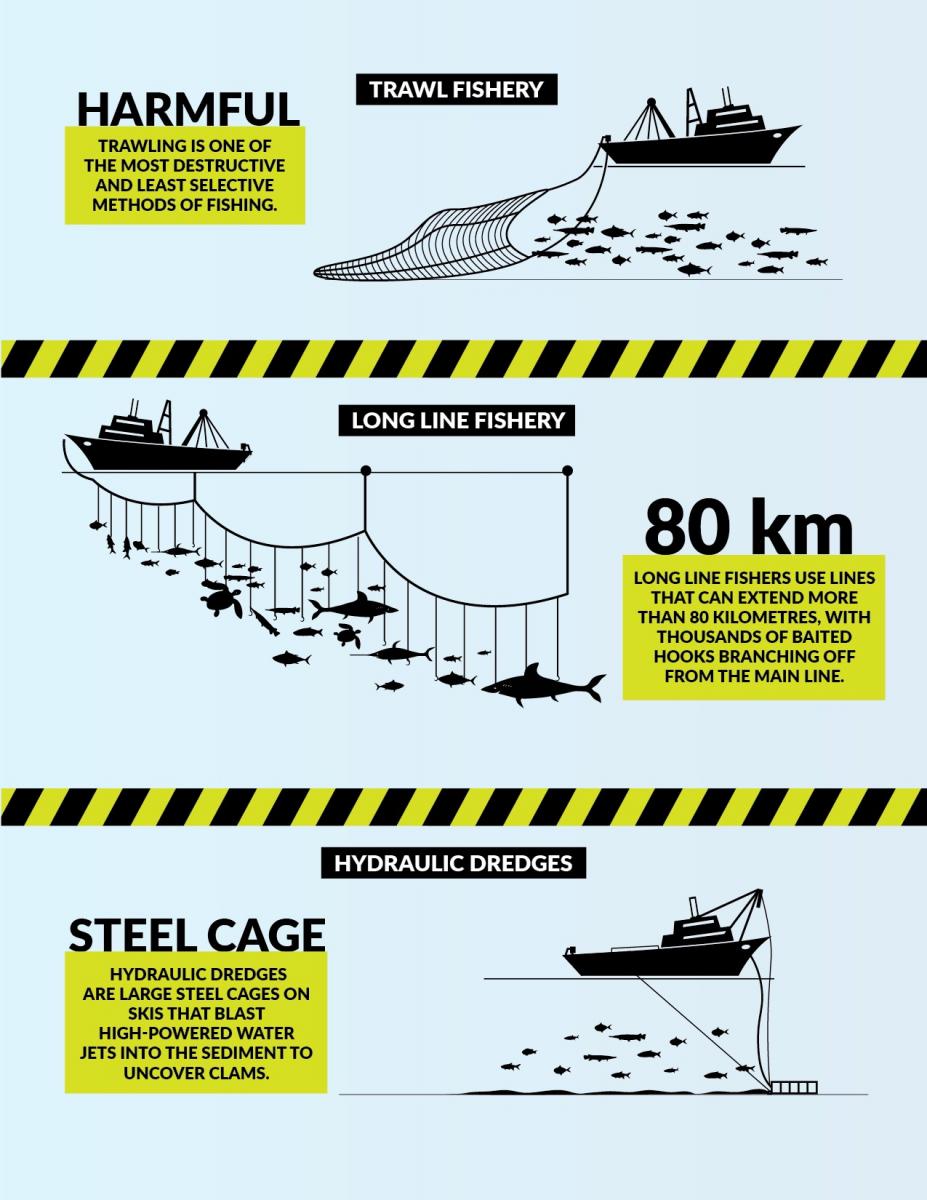May 18, 2017
How is Seafood Caught? A Look at Fishing Gear Types in Canada
Estimated reading time: 0 minutes
Seafood harvested in Canada are caught by a wide variety of fishing gears. Some gear types are known to be harmful to the health of the ocean because they are non-selective, removing species indiscriminately and damaging habitat. Up to 10.3 million tonnes of sea life is unintentionally caught each year around the world, captured in nets, lines and other gear. Bycatch is a destructive and wasteful practice that harms many species including those with threatened and endangered populations like sea birds, sharks, sea turtles, whales and fish. According to our report, Collateral damage: How to reduce bycatch in Canada’s commercial fisheries, three gear types identified as causing high amounts of bycatch are trawls, longlines and dredges.

Trawls
How does it work?
Bottom trawling is one of the most destructive and least selective methods of fishing. It involves dragging weighted nets across the sea floor. These nets are often enormous and capture almost everything in their path. In the process, they may damage vulnerable habitat. Trawls can also be used above the sea floor, called mid-water trawls, a process that also scoops up bycatch.
Why is it used?
Many groundfish fisheries in Atlantic Canada use bottom trawls to catch Atlantic cod, haddock, Atlantic halibut, redfish and flounders. Mid-water trawls are used to harvest schooling fish, they are able to catch entire schools of fish like Pacific hake and Atlantic herring.
Could we make it more sustainable?
Modifications to trawls can minimize some of the impacts. For example, the Nordmore grate is a sorting device used in the Northern shrimp fishery to separate bycatch. Many commercial species that are targeted by trawls can be fished using other methods that are more selective and less destructive to habitat.
Longlines
How does it work?
Longlines are extremely long fishing lines that have thousands of individual baited hooks branching off of the main lines. They can extend more than 80 kilometres and can be used either along the seafloor or closer to the surface depending on the species being targeted. The baited hooks — which are sometimes left to “soak” for several hours — attract many species that are not targeted by fishers, including diving birds. If a bird or another animal becomes hooked, it is often seriously injured or dead by the time the gear is retrieved.
Why is it used?
Longlines on the sea floor target cod, rockfish and flatfish, ones closer to the surface are used in fisheries for tuna and swordfish.
Could we make it more sustainable?
Using circle hooks on longlines can reduce bycatch of turtles, while attaching streamers to lines can reduce bird bycatch. Using harpoons, handlines, greenstick or buoy gear instead of long lines are more sustainable options that have proven to reduce bycatch.
Dredges
How does it work?
Dredges are essentially large steel cages on skis that are dragged across the ocean floor. Regular dredges have large metal teeth, which dig into the seafloor to lift their catch up into the basket. Hydraulic dredges, on the other hand, shoot high-powered jets of water into the sediment to expose and scoop up the species that they’re targeting. This process of dredging causes short-term and long-term changes to the sediment and associated marine life.
Why is it used?
Dredges are used in shellfish fisheries to harvest species that live in the sediments on the ocean floor, such as clams and scallops
Could we make it more sustainable?
In shallow water, diving or using rakes, shovels, clam tubes, and tongs can reduce seafloor damage. Because there are no economically viable alternatives in deeper water, habitat protection measures are important.
Take action
Help call on the Canadian government to reduce bycatch by signing this petition. Together, we can reduce the unnecessary waste and harm to sea life.

